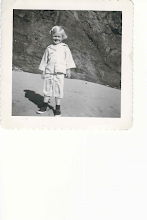 |
| Binder similar to the one used on the Doc Hunt place. |
Farm children learn early to respect the equipment used on the farm. While safety has improved over the last hundred years, children (and adults) still get hurt farming.
I learned a very
hard lesson about machinery there on the Doc Hunt place and picked up a
permanent scar from it. One day in late
summer, Dad was running the mule-drawn binder cutting oats. A binder was a big machine with a sickle bar
in front to cut grain and a big wooden reel that pushed the rain stalks onto
the belt. The belt carried the grain
into the clattering machinery where it was automatically tied in bundles to be
gathered up into “shocks” until time to haul them to the threshing machine. (Nowadays the whole process is done with
combines so you never see a binder any more outside of a museum.)
Dad had a very
mismatched team of mules hooked to that binder.
One was a sorrel we called “Red” and he was fat and lazy. The other was a tall, raw-boned, hard-working
old mule that was sort of black with a bluish tint. Inevitably, his name was “Old Blue.”
 |
| Before modern farm equipment, mules, a cross between horse and donkey, were ubiquitous on the Missouri landscape |
Those mules were
as different as day and night. Old Blue
would pull his heart out all day, but not that lazy Red. He would always sag back pulling only what he
had to until his end of the doubletree would rest against the front of the
binder, plow, wagon, or whatever the team was hooked to. Dad would get so mad that he would yell words
at that red mule that I was not supposed to know (I knew them anyway only never
used them around my mother or grandparents else I would get my mouth washed out
with a soapy rag). Dad would whip that
red mule wither with the reins or with a whip made out of plaited strips of
green elder bark.
You never had to
cuss or whip Old Blue. When you shook
the reins and yelled, “Giddup!”, Old Blue would dig in his hooves and pull for
all he was worth until you pulled him up again.
Well, anyway, on
this particular day Dad was cutting a field of oats with the binder. The seat on a binder was up real high so the
driver could see over the machinery. I
was coming across the field from the creek and decided I would hitch a ride on
the back of the binder, which I had done before.
My intention was
to run up behind the binder and jump onto a bar down low while I grabbed the
curved seat support to hand on. It would
have worked just fine except as I lunged for the seat my food slipped. My hand missed the seat bracket and went
right into one of those big gears, then between it and the chain.
My father pulled
up the mules as soon as he heard me yell—and I expect they probably heard me
clear over to Polk County—but my hand had already gone in far enough that it
threw off that big square-linked chain.
It did not break any bones, but one of the big gear teeth gashed my palm
so deep that you could have put a quarter in there—well, a nickel at
least. Of course I was bleeding like a
stuck hog.
 |
| 1925 Model T Ford, similar to the one Ernest Frieze drove from Washington to Missouri |
Dad jumped down,
wound his red bandana around my hand and hustled me off to the house. Mother was quite upset, of course. She bundled me into our old Model T Ford and
we went flying down that dusty dirt road to the doctor in Fair Play. He fixed up my hand and gave me a tetanus
shot, which I did not like much. The
hand healed pretty quick, but forever I have had an inch-long scar in the palm
of my right hand.

